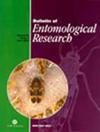The bug-killer fly Gymnosoma rotundatum (L.) (Diptera: Tachinidae) forms the respiratory funnel independently of the host's immune response
IF 1.6
3区 农林科学
Q2 ENTOMOLOGY
引用次数: 0
Abstract
In internal parasitism, the respiration strategy within the host's body is as essential as evading attack from the host's immune system. Tachinid flies are parasitoids of terrestrial arthropods, mostly insects, during their larval stage. To obtain oxygen while living in the host body, they build a cylindrical structure known as the respiratory funnel at the aperture opened by the tachinid larva on the host integument or trachea. These funnels can be divided morphologically into sheath and cone types. Previous research on sheath-type funnels revealed that they are derived from the encapsulating substance produced by the host's immune system. In contrast, the cone-type funnels cover part of the body of the larval tachinid and may be constructed independently from the host immune system. To determine the mechanisms of cone-type funnel formation, histological observations were carried out on杀虫蝇Gymnosoma rotundatum (L.)(双翅目:恙螨科)形成呼吸漏斗与宿主的免疫反应无关
在体内寄生中,宿主体内的呼吸策略与躲避宿主免疫系统的攻击一样重要。蜚蠊是陆生节肢动物(主要是昆虫)幼虫阶段的寄生虫。为了在寄主体内生活时获得氧气,它们会在寄主体表或气管上由喙蝇幼虫打开的孔口处建造一个称为呼吸漏斗的圆柱形结构。这些漏斗从形态上可分为鞘型和锥型。以前对鞘型漏斗的研究表明,它们来自宿主免疫系统产生的包裹物质。与此相反,锥型漏斗覆盖了幼虫蛛体的一部分,可能是独立于宿主免疫系统而构建的。为了确定锥形漏斗的形成机制,研究人员对具有这种漏斗的 Gymnosoma rotundatum (L.)(双翅目:恙螨科)进行了组织学观察。研究发现,Gymnosoma rotundatum 的呼吸漏斗是由蝇幼虫排出的管状粪便包裹着包膜形成的,而不是来自宿主组织或血细胞。此外,在 G. rotundatum 幼虫肛板周围还发现了可能参与漏斗形成的分泌腺。通过比较蜚蠊科的漏斗类型,发现法氏囊虫科和德氏囊虫科的漏斗为锥形,其形成机制可能与轮纹蜚蠊相同。这些新发现表明,不利用宿主免疫系统的漏斗形成与蛛形纲的系统发育有关。
本文章由计算机程序翻译,如有差异,请以英文原文为准。
求助全文
约1分钟内获得全文
求助全文
来源期刊
CiteScore
4.00
自引率
0.00%
发文量
160
审稿时长
6-12 weeks
期刊介绍:
Established in 1910, the internationally recognised Bulletin of Entomological Research aims to further global knowledge of entomology through the generalisation of research findings rather than providing more entomological exceptions. The Bulletin publishes high quality and original research papers, ''critiques'' and review articles concerning insects or other arthropods of economic importance in agriculture, forestry, stored products, biological control, medicine, animal health and natural resource management. The scope of papers addresses the biology, ecology, behaviour, physiology and systematics of individuals and populations, with a particular emphasis upon the major current and emerging pests of agriculture, horticulture and forestry, and vectors of human and animal diseases. This includes the interactions between species (plants, hosts for parasites, natural enemies and whole communities), novel methodological developments, including molecular biology, in an applied context. The Bulletin does not publish the results of pesticide testing or traditional taxonomic revisions.

 求助内容:
求助内容: 应助结果提醒方式:
应助结果提醒方式:


